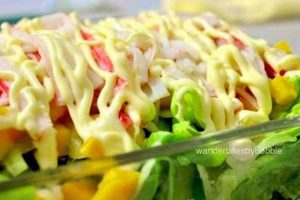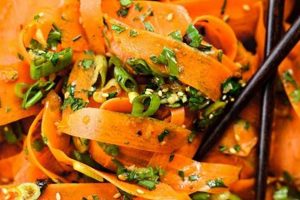Arugula, also known as rucola and roquette, lends its peppery, distinctive flavor to a simple salad composed of fresh leaves, often combined with other ingredients. A basic preparation might include olive oil, lemon juice, Parmesan cheese, and salt and pepper. More complex variations can incorporate ingredients such as toasted nuts, dried cranberries, or other cheeses like goat cheese or gorgonzola. The dish offers a light yet flavorful accompaniment to heavier main courses.
These preparations offer a good source of vitamins A, C, and K, as well as minerals like potassium and calcium. Their simple nature allows for quick preparation, making them an ideal choice for a healthy and convenient meal. Historically, arugula has been cultivated and consumed in the Mediterranean region for centuries, and its popularity has spread globally due to its versatility and nutritional value. It features prominently in various cuisines, adding a unique element to salads, pizzas, and sandwiches.
The following sections will explore a range of preparation methods, from basic vinaigrette dressings to more elaborate creations, catering to different tastes and dietary needs. Variations using seasonal ingredients will also be highlighted, offering year-round inspiration for incorporating this nutritious green into one’s diet.
Tips for Preparing Arugula Salad
Achieving optimal flavor and texture requires attention to detail throughout the preparation process. The following tips offer guidance for creating a delightful culinary experience.
Tip 1: Source High-Quality Arugula: Select vibrant, deep green leaves that appear fresh and crisp. Avoid bunches with wilted or yellowing leaves.
Tip 2: Proper Washing and Drying: Thoroughly rinse arugula under cold water to remove any soil or debris. Use a salad spinner to dry the leaves completely, preventing a soggy salad.
Tip 3: Timing is Key: Dress the salad immediately before serving. This prevents the leaves from wilting and maintains their crisp texture.
Tip 4: Balancing Flavors: The peppery bite of arugula pairs well with acidic elements like lemon juice or vinegar and creamy textures like cheese or avocado. Strive for a balanced flavor profile.
Tip 5: Consider Complementary Ingredients: Enhance the salad with ingredients that complement arugula’s flavor, such as toasted pine nuts, sun-dried tomatoes, or shaved Parmesan.
Tip 6: Oil Selection Matters: Extra virgin olive oil is a classic choice, but other oils like walnut or avocado oil can offer interesting nuances.
Tip 7: Seasoning Appropriately: Seasoning with salt and freshly ground black pepper enhances the overall flavor. Be mindful not to over-salt.
By following these guidelines, one can consistently create a delicious and satisfying salad that showcases the distinctive qualities of this versatile green. A well-prepared arugula salad offers a refreshing and nutritious addition to any meal.
These tips offer a foundation for exploring the diverse world of arugula salad preparations. The following conclusion will summarize the key elements discussed and encourage further culinary experimentation.
1. Fresh, High-Quality Arugula
Fresh, high-quality arugula forms the foundation of any successful rocket salad. The inherent peppery, slightly bitter flavor of the leaves is central to the salad’s character. Without fresh, vibrant arugula, the final dish risks lacking the distinctive taste experience. Wilted or yellowing leaves indicate age and diminished quality, resulting in a less flavorful, potentially unpleasant salad. The difference between fresh and subpar arugula directly impacts the overall enjoyment of the dish. Consider a salad made with vibrant, crisp arugula versus one made with wilted leaves: the former offers a bright, peppery bite, while the latter presents a flat, potentially bitter taste.
This connection underscores the importance of sourcing the best ingredients. Grocery stores and farmers’ markets offer opportunities to visually assess arugula quality. Look for deep green leaves free from blemishes or signs of wilting. Proper storage also plays a crucial role in maintaining freshness. Refrigerating arugula in a loosely sealed bag with a paper towel helps preserve its crispness and flavor. Failing to prioritize quality ingredients compromises the intended flavor profile and diminishes the nutritional value of the salad. A salad featuring premium arugula provides not only a superior taste experience but also maximizes the intake of vitamins and minerals inherent in fresh greens. Consider the contrast in visual appeal: a salad with vibrant green arugula is far more appetizing than one with dull, wilted leaves.
Prioritizing fresh, high-quality arugula is essential for creating a successful rocket salad. The flavor and overall quality of the salad directly correlate to the condition of the primary ingredient. Careful selection and proper storage techniques contribute significantly to the dish’s success. Investing in high-quality arugula guarantees a more enjoyable and nutritious culinary experience. This principle extends to all culinary endeavors: the quality of ingredients directly impacts the final product.
2. Complementary Ingredients
Complementary ingredients elevate a simple rocket salad from basic to exceptional. The inherent peppery bite of arugula provides a robust base, inviting a range of flavor and texture pairings. These additions not only diversify the salad but also offer nutritional benefits and enhance visual appeal. The strategic incorporation of complementary ingredients transforms the overall sensory experience. Consider the interplay of textures: crunchy toasted nuts or seeds contrast beautifully with the soft leaves, adding a satisfying dimension. Flavor pairings offer similar complexity. The sharpness of Parmesan cheese balances the peppery arugula, while the sweetness of dried cranberries or caramelized onions introduces a contrasting note. This layered approach to flavor and texture development is crucial for a well-rounded rocket salad.
Specific examples illustrate the practical significance of ingredient selection. Toasted pine nuts contribute a buttery richness and satisfying crunch, complementing arugula’s peppery notes. Similarly, crumbled goat cheese adds a creamy tang, balancing the bitterness while offering a textural contrast. Sliced pears or figs introduce a subtle sweetness and a soft, yielding texture that complements the peppery greens. Even a sprinkle of toasted sesame seeds can dramatically alter the salad’s flavor profile, introducing a nutty aroma and a delicate crunch. These examples demonstrate the potential of complementary ingredients to transform a simple rocket salad into a complex and satisfying culinary creation. The choice of ingredients can also reflect seasonal availability, allowing for variations throughout the year, showcasing the adaptability of the basic recipe. A winter salad might include roasted butternut squash and pomegranate seeds, while a summer version might feature fresh berries and grilled peaches.
Ingredient selection in rocket salad preparation is a critical step toward achieving a balanced and flavorful result. Understanding the interplay of flavors and textures allows for informed decisions that elevate the dish beyond its basic components. The use of complementary ingredients not only diversifies the sensory experience but also contributes to a nutritionally richer and visually appealing meal. Challenges may include finding the optimal balance between contrasting elements, but experimentation and mindful tasting yield satisfying results. The principle of complementary flavors and textures extends beyond salads, influencing culinary practices across a range of dishes, highlighting its fundamental importance in gastronomy.
3. Balanced Flavor Profiles
Balanced flavor profiles are essential to a successful rocket salad recipe. The inherent peppery, sometimes bitter, nature of arugula necessitates careful consideration of other ingredients to achieve a harmonious taste. A balanced profile prevents any single flavor from dominating, ensuring a more nuanced and enjoyable culinary experience. The interplay of contrasting tastesbitter, sweet, sour, salty, and umamicreates complexity and depth. Without this balance, the salad may be overly bitter or lack the complexity expected of a well-composed dish. This balance is not merely about masking the bitterness of arugula, but about enhancing its unique characteristics by creating a symphony of flavors that complement and contrast with each other. For instance, a salad with only arugula and a strong vinaigrette may overwhelm the palate with acidity, while a salad with only arugula and sweet fruit might lack the necessary savory depth. A well-balanced rocket salad, however, might incorporate the peppery arugula, a sweet and acidic vinaigrette, salty Parmesan cheese, and earthy toasted nuts, offering a complex and satisfying interplay of flavors.
The practical application of this understanding involves carefully selecting ingredients that contribute to the overall balance. Acidity, often from a citrus vinaigrette, cuts through the richness of cheese and nuts while tempering the peppery arugula. Sweet elements, such as dried cranberries or caramelized onions, offer a counterpoint to the bitterness and acidity. Salty components, like Parmesan or feta cheese, enhance other flavors and provide a savory dimension. Umami, often contributed by ingredients like toasted nuts or sun-dried tomatoes, adds depth and complexity. The proportions of each ingredient are crucial; too much of any one element can disrupt the balance. Consider the difference between a salad with a light sprinkling of Parmesan versus one heavily laden with cheese: the former allows the other flavors to shine, while the latter might overpower the palate with saltiness. Careful attention to these nuances ensures a well-rounded and enjoyable final product.
Achieving a balanced flavor profile in a rocket salad requires a thoughtful approach to ingredient selection and proportion. This balance enhances the inherent qualities of arugula, creating a more complex and satisfying dish. While the specific combination of ingredients can vary, the underlying principle of balance remains constant. Challenges may arise in balancing contrasting flavors, especially when incorporating new or unfamiliar ingredients. Experimentation and careful tasting are key to navigating these challenges and achieving the desired result. The ability to create balanced flavor profiles extends beyond rocket salad, serving as a fundamental principle in culinary arts, applicable to a wide range of dishes and cuisines.
4. Proper Washing and Drying
Proper washing and drying are crucial steps in preparing a rocket salad recipe. These procedures directly impact the final dish’s quality, affecting both flavor and texture. Thorough cleaning removes soil and debris, ensuring food safety and preventing gritty textures. Proper drying prevents a soggy salad, maintaining the crispness of the arugula leaves and allowing the dressing to adhere properly. Neglecting these steps compromises the overall dining experience.
- Food Safety and Cleanliness
Washing removes potential contaminants, such as soil, insects, and pesticides, promoting food safety. Rinsing under cold running water is the most effective method. Soaking is not recommended as it can cause the delicate leaves to become waterlogged and lose nutrients. This process ensures a clean and safe salad, mitigating potential health risks associated with consuming unwashed produce. For example, residual pesticides or bacteria present on unwashed leaves can pose health risks if ingested.
- Texture Preservation
Thorough drying is essential for maintaining the crisp texture of arugula. Excess water dilutes the dressing and makes the salad soggy. A salad spinner effectively removes excess moisture without damaging the leaves. Alternatively, gently patting the leaves dry with a clean kitchen towel or paper towels can achieve similar results. This step preserves the desirable texture of the arugula, preventing a wilted and unappetizing salad. Consider the difference between biting into a crisp, refreshing leaf versus a soggy, limp one: the textural contrast highlights the importance of proper drying.
- Flavor Enhancement
Properly dried arugula allows the dressing to coat the leaves evenly, enhancing flavor distribution. Excess moisture dilutes the dressing, diminishing its impact and potentially leading to a bland salad. Dry leaves also provide a better surface for other ingredients, such as cheese or nuts, to adhere to, ensuring a more balanced and flavorful bite. This contributes significantly to the overall enjoyment of the dish. A well-dressed salad, where each leaf is coated evenly with a flavorful vinaigrette, provides a more satisfying experience compared to a salad with a diluted, watery dressing.
- Visual Appeal
Washing and drying contribute to the visual appeal of the salad. Clean, dry leaves appear vibrant and fresh, enhancing the overall presentation. Wet leaves, on the other hand, can appear limp and less appetizing. The visual appeal of a dish contributes significantly to the dining experience, influencing perceptions of freshness and quality. A salad with glistening, dry leaves presents a far more appealing image than a salad with wilted, wet greens. This aspect emphasizes the attention to detail required for a truly successful rocket salad preparation.
Proper washing and drying techniques are essential components of a successful rocket salad recipe. These procedures contribute to food safety, preserve texture, enhance flavor, and improve visual appeal. The attention to detail in these seemingly simple steps significantly impacts the final dish, underscoring the importance of careful preparation in achieving a high-quality culinary result. A well-prepared rocket salad offers a delightful sensory experience, demonstrating the interconnectedness of technique and quality in culinary endeavors.
5. Timely Dressing Application
Timely dressing application is critical to a successful rocket salad recipe. Arugula’s delicate leaves are susceptible to wilting when exposed to acidic dressings for extended periods. Delayed dressing preserves the leaves’ crisp texture and vibrant appearance, essential components of an appealing and palatable salad. Premature dressing application results in a soggy, wilted salad with diminished visual appeal and compromised textural integrity. This cause-and-effect relationship underscores the importance of timing in achieving optimal results. Consider a salad dressed an hour before serving compared to one dressed immediately prior: the former will likely exhibit wilted leaves and a watery consistency, while the latter maintains its fresh, crisp texture. This direct comparison illustrates the practical implications of timely dressing.
The practical significance of this understanding translates directly to improved culinary outcomes. Preparing the dressing in advance allows for efficient assembly just before serving. Keeping the dressing and salad components separate until the last moment ensures optimal freshness and texture. This practice is particularly crucial for large gatherings or meal preparations where immediate consumption is not guaranteed. Imagine a buffet setting where a large bowl of rocket salad is dressed hours in advance. The inevitable result is a disappointing dish of wilted, soggy leaves. Conversely, individual portions dressed just before serving maintain their fresh appeal and provide a more enjoyable dining experience. This distinction highlights the practical benefits of applying dressing at the appropriate time.
Timely dressing application is a fundamental aspect of rocket salad preparation. This practice preserves the textural integrity and visual appeal of the delicate arugula leaves. The difference between a crisp, vibrant salad and a wilted, soggy one often hinges on this single detail. While seemingly minor, this step significantly impacts the overall dining experience. Challenges in coordinating timely dressing can arise in situations involving large-scale preparations or events. Strategic planning, such as preparing individual salad portions or keeping dressing separate until the point of service, mitigates these challenges and ensures a consistently high-quality result. This principle extends beyond rocket salad, applying to other delicate greens and highlighting its broader relevance in culinary practice.
Frequently Asked Questions about Rocket Salad
This section addresses common inquiries regarding rocket salad preparation and consumption, offering practical guidance for optimal results.
Question 1: How does one prevent rocket salad from becoming soggy?
Sogginess results from premature dressing application or insufficient drying of the leaves after washing. Dress the salad immediately before serving and ensure thorough drying with a salad spinner or clean towels.
Question 2: What are suitable substitutes for Parmesan cheese?
Pecorino Romano, Grana Padano, or aged Manchego offer similar salty, hard textures. For a milder flavor, consider ricotta salata or feta cheese. Nutritional yeast provides a vegan alternative.
Question 3: Can other nuts or seeds be used besides pine nuts?
Toasted walnuts, pecans, slivered almonds, or sunflower seeds provide textural and flavor variations. Consider the specific flavor profile desired when selecting alternatives.
Question 4: How long can rocket salad be stored?
Undressed rocket can be stored in a refrigerator for up to three days when properly sealed in a container or bag with a paper towel. Dressed salad is best consumed immediately.
Question 5: How can one balance the peppery flavor of rocket?
Sweet or acidic ingredients effectively balance rocket’s peppery bite. Consider incorporating dried cranberries, caramelized onions, balsamic vinegar, or lemon juice.
Question 6: What are the nutritional benefits of consuming rocket salad?
Rocket is a good source of vitamins A, C, and K, and minerals such as folate, calcium, and potassium. It also contains antioxidants beneficial for overall health.
Understanding these key aspects of preparation and consumption ensures a consistently enjoyable and nutritious rocket salad experience.
For further exploration, the following section offers a collection of varied rocket salad recipes to inspire culinary creativity.
Rocket Salad Recipe
Exploration of rocket salad recipes reveals the interplay of fresh, high-quality ingredients, balanced flavor profiles, and proper handling techniques as crucial elements for culinary success. From sourcing vibrant arugula to the timely application of dressing, each step contributes significantly to the final dish’s quality. Complementary ingredients, carefully chosen to enhance both flavor and texture, elevate the simple salad to a more complex and satisfying culinary experience. Proper washing and drying techniques maintain the arugula’s crispness and contribute to food safety. An understanding of these key elements empowers culinary enthusiasts to create exceptional rocket salads consistently.
Rocket salad, seemingly simple in its composition, offers a canvas for culinary creativity. The foundational principles discussed herein provide a framework for experimentation and adaptation. Continued exploration of flavor combinations and ingredient pairings allows for the development of personalized variations, reflecting individual preferences and seasonal availability. The potential for culinary innovation within this seemingly basic recipe remains vast, promising a continuous journey of discovery for those willing to experiment.






